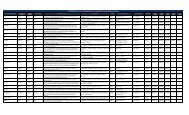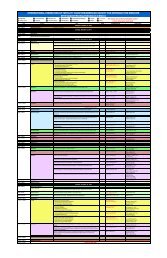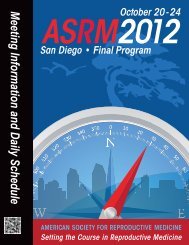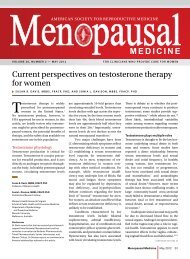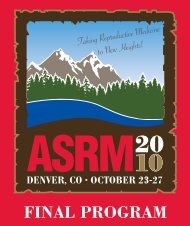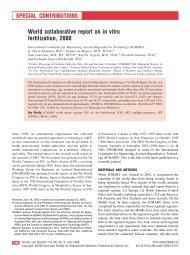scientific program • symposia - American Society for Reproductive ...
scientific program • symposia - American Society for Reproductive ...
scientific program • symposia - American Society for Reproductive ...
You also want an ePaper? Increase the reach of your titles
YUMPU automatically turns print PDFs into web optimized ePapers that Google loves.
BETTER PCOS TREATMENT? OVARIAN STIMULATION VS.<br />
IN VITRO MATURATION<br />
Presented by the Asia Pacific Initiative on Reproduction<br />
Yoshiharu Morimoto, M.D., Ph.D. (Chair)<br />
IVF Japan, Japan<br />
Bruno Lunenfeld, M.D., Ph.D.<br />
Bar-Ilan University, Israel<br />
Aisaku Fukuda, M.D., Ph.D.<br />
IVF OSAKA Clinic, Japan<br />
Jie Qiao, M.D., Ph.D.<br />
Third Hospital, Beijing, China<br />
SCIENTIFIC PROGRAM <strong>•</strong> SYMPOSIA<br />
Wednesday, October 19, 2011 11:45 am – 1:00 pm<br />
Symposium<br />
Room 224 A/B<br />
Needs Assessment and Description<br />
In vitro maturation (IVM) has been applied worldwide in<br />
the treatment of patients with polycystic ovary syndrome<br />
(PCOS). However, success rates differ among centers and<br />
the practice is not mainstream. Conventional methods of<br />
ovarian stimulation may result in ovarian hyperstimulation<br />
syndrome (OHSS), but this is still an effective choice <strong>for</strong> some<br />
patients with PCOS. There is, however, limited in<strong>for</strong>mation<br />
comparing these two protocols. This session <strong>for</strong> physicians,<br />
reproductive scientists and healthcare professionals involved<br />
in assisted reproductive technologies will examine the two<br />
methods in the treatment of patients with PCOS.<br />
PREIMPLANTATION GENETIC SCREENING: IS THERE A<br />
LEGITIMATE INDICATION AND METHOD?<br />
Presented by the <strong>Society</strong> <strong>for</strong> Assisted <strong>Reproductive</strong> Technology and the<br />
Preimplantation Genetic Diagnosis Special Interest Group<br />
Catherine Racowsky, Ph.D. (Chair)<br />
Brigham and Women’s Hospital<br />
Dagan Wells, Ph.D., B.Sc.<br />
University of Ox<strong>for</strong>d<br />
Richard T. Scott, Jr., M.D.<br />
<strong>Reproductive</strong> Medicine Associates of New Jersey<br />
Mark R. Hughes, M.D., Ph.D.<br />
Genesis Genetics Institute<br />
Needs Assessment and Description<br />
While emerging technologies <strong>for</strong> preimplantation genetic<br />
screening (PGS) of all chromosomes hold promise <strong>for</strong><br />
accurate identification of euploid embryos, controversy<br />
exists regarding the strategies used and the patient<br />
populations who may benefit most. <strong>Reproductive</strong> specialists<br />
need to be updated on the technical aspects and clinical<br />
applications of the technologies, in order to provide<br />
appropriate patient counseling, and to consider practice<br />
pattern changes <strong>for</strong> improved patient care.<br />
Learning Objectives<br />
At the conclusion of this session, participants should be able<br />
to:<br />
1. Compare the different methodologies currently used <strong>for</strong><br />
preimplantation genetic screening.<br />
2. Summarize the extent to which aneuploidy affects<br />
embryo morphology.<br />
3. Discuss the impact of biopsy at different developmental<br />
78<br />
Learning Objectives<br />
At the conclusion of this session, participants should be able<br />
to:<br />
1. Describe basic and clinical concepts of IVM technology.<br />
2. Assess and compare two major protocols, ovarian<br />
stimulation and IVM, <strong>for</strong> treatment of women with PCOS.<br />
ACGME COMPETENCY<br />
Medical Knowledge<br />
Patient Care<br />
TEST QUESTION:<br />
For patients with PCOS, after participating in this session,<br />
I will do following in my practice:<br />
A. Use ovarian stimulation <strong>for</strong> the first cycle and use IVM <strong>for</strong><br />
the second trial.<br />
B. Not use met<strong>for</strong>min, as it is not effective with the IVM<br />
procedure.<br />
C. Choose IVM <strong>for</strong> patients who have experienced severe<br />
OHSS in previous cycles.<br />
D. Use only anti-müllerian hormone assessment prior to<br />
treatment.<br />
E. Use IVM <strong>for</strong> all patients, as the maturation rate of<br />
immature oocytes in IVM is commonly 80%.<br />
F. Not applicable to my area of practice.<br />
Wednesday, October 19, 2011 3:45 pm – 5:45 pm<br />
Symposium<br />
Room 330 E<br />
stages on the precision and safety of emerging<br />
technologies and on the clinical outcomes achieved.<br />
4. Describe the patient populations who may benefit most<br />
from preimplantation genetic screening.<br />
ACGME COMPETENCY<br />
Medical Knowledge<br />
Patient Care<br />
TEST QUESTION:<br />
A 34-year-old, G3PO, has undergone three failed IVF cycles<br />
with her 36-year-old partner, who presents with a normal<br />
semen analysis. She has obtained a total of 18, 16 and 22<br />
embryos in these three failed attempts, all of which have<br />
resulted in chemical pregnancies following transfer of 2<br />
embryos. It is recommended that their embryos undergo<br />
preimplantation genetic screening in their fourth IVF cycle.<br />
The couple has read about microarray technology and<br />
they wonder whether this should be used on their embryos.<br />
After participating in this session, in my practice be<strong>for</strong>e<br />
attempting their fourth cycle I will counsel this couple that:<br />
A. There is no risk of decreased implantation with embryo<br />
biopsy.<br />
B. Preimplantation genetic screening with microarray<br />
technology completely eliminates the risk of transferring<br />
an aneuploid embryo.<br />
C. SNP microarray-based 24-chromosome aneuploidy<br />
screening provides more complete and consistent results<br />
than FISH.<br />
D. Only half of their embryos should be biopsied.<br />
E. Not applicable to my area of practice.



